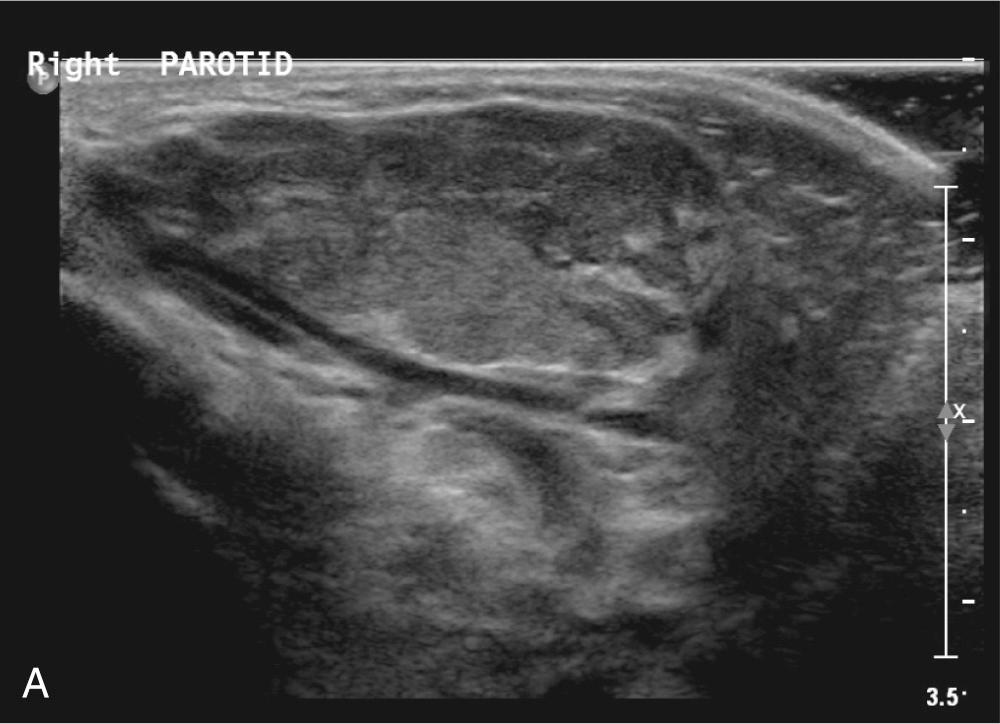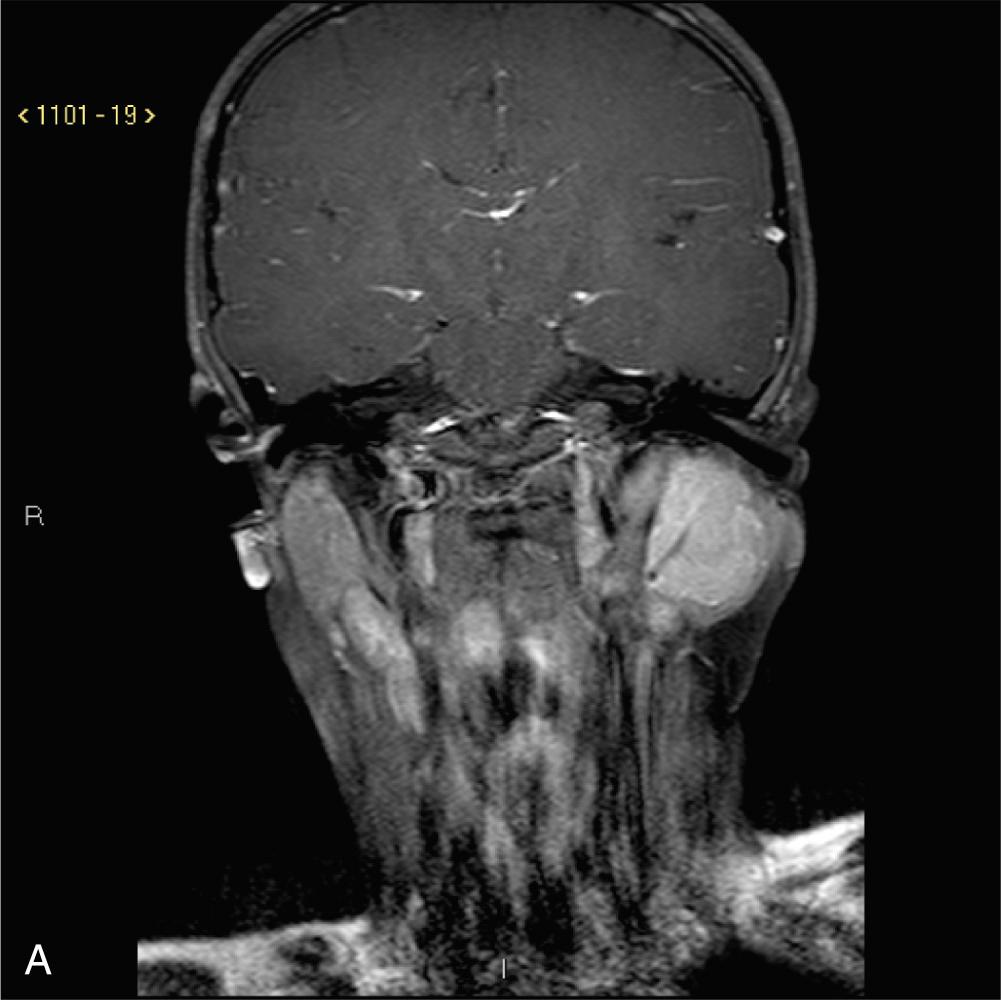Physical Address
304 North Cardinal St.
Dorchester Center, MA 02124
Salivary neoplasms are uncommon in children. They may arise in the acini and ducts (epithelial tumors) or in mesenchymal tissue, e.g., the intraparotid lymphoid (lymphoma) or connective tissue (neurofibroma, schwannoma, rhabdomyosarcoma). They may be benign or malignant. Head and neck tumors of non-salivary origin may infiltrate the salivary glands, and the most common tumors encountered in children are lymphovascular lesions, which may be locally aggressive and rapidly proliferate, but are not true neoplasms.
Infantile hemangiomas are the most common tumors of the salivary glands in children. Some 90% occur in the parotid, usually presenting within a few weeks of birth. They follow a proliferative phase for 6–9 months, followed by involution, usually completed by 3–5 years. Most have extensive cutaneous involvement such that the diagnosis is clinically obvious, but some present as a palpable mass or an area of focal swelling with normal overlying skin. They cause a great deal of parental anxiety and are often thought to represent advanced malignancy, but imaging will show the characteristic appearance ( Figs. 8.1.1 , 8.1.2 ) and avoid the need for biopsy. Hemangiomas can usually be observed with no active medical or surgical intervention. Resolution can be hastened by the use of systemic propranolol. A small number of highly proliferative cases show rapid proliferation – e.g., Kaposiform hemangioendothelioma, an intermediate between a hemangioma and a malignant angiosarcoma – and in some cases there is extensive swelling encroaching on the orbit, or infiltrating the airway. Treatment with chemotherapy agents such as methotrexate, under the supervision of a pediatric oncologist, may be offered in these rare cases.


Lymphatic malformations may originate within the parotid (Type 1) but more often the gland is infiltrated by a lymphatic malformation of the surrounding tissue (Type II). The majority of patients with lymphatic malformations present at birth or within a few months, but cases have been diagnosed in late childhood and into adulthood. The typical presentation is of a painless, soft, fluctuant mass. Their growth is generally in proportion to the patient's body growth, but infection and bleeding can lead to an acute increase in size. Clinical examination alone is insufficient to identify the extent, especially in the deep portion of the parotid gland. Sonography is useful but the deeper invasive disease is best shown by MRI. A T2-weighted image will enhance the malformation very effectively. Complete excision via a partial or total parotidectomy with facial nerve preservation is the method of choice for type I lymphatic malformation of the parotid gland. Preservation of the facial nerve should be achievable in all cases, but the nerve is often elongated and its course is aberrant as the malformation encompasses, deflects or buries it. Type II malformations may be more complex. Complete excision as a one-stage procedure is most likely to achieve complete eradication, but attempts to completely remove the deep infiltrative malformation may result in a serious functional deficit, and sclerosing agents, usually administered under the supervision of an interventional radiologist, are becoming more widely used either alone or as an adjunct to surgery.
Benign epithelial tumors typically present as a painless, palpable, asymptomatic, slow-growing mass. Minor salivary gland neoplasms, though rare, have been reported in children. As in adults, the commonest benign tumor is the pleomorphic salivary adenoma (PSA). Parotid gland PSAs occur most commonly in the lateral lobe, followed by the deep lobe and the parapharyngeal space. They occur in children as young as 1 year old, but the mean age in children is 15 years. Investigation and management is similar to adult practice, but fine needle aspiration (FNA) is less reliable in children, who may not tolerate it well. Imaging is an essential part of the work-up, but MRI scanning in children will often require a general anesthetic.
Malignant epithelial tumors are rare in children, with an incidence of 1 per million population. Parotid tumors in children cause a great deal of anxiety and it is often said that the proportion of malignant-to-benign tumors is higher in children than in adults, but a recent National Cancer Registration-based report from Denmark reports that this was not so. Most cases present in the second decade of life, but if such a tumor presents in a child under 10 years old, then it is more likely to be of a high grade with a poorer prognosis. Approximately 50% will report pain, and occasionally there is facial nerve palsy or tethering of the skin. Mucoepidermoid carcinoma is the most common (50%) followed by acinic cell (35%), with adenocarcinoma and adenoid cystic carcinoma accounting for most of the rest.
Mesenchymal tumors such as benign neuroblastoma, schwannoma, and primary neuroectodermal/Ewing sarcoma can also present. The salivary glands in children – particularly the parotid – have a high proportion of lymphoid tissue, and head and neck lymphomas not infrequently involve the parotid gland. Diagnosis can be delayed in children due to the rarity of these lesions and because they are assumed to be “reactive lymph nodes”. Rhabdomyosarcomas (RMS) are the most common malignancies of the head and neck in children, and not infrequently involve the salivary glands ( Figs. 8.1.3 , 8.1.4 ). They are designated by their location, and involvement of salivary glands is classified as “non-orbital, non-parameningeal”. RMS usually affects young children and adolescents, with most cases occurring before the age of 10 years. All three histologic variants of RMS have been reported as affecting salivary glands: embryonal (most common), spindle cell, and alveolar (the poorest prognosis). The presenting signs and symptoms may include a slow-growing facial lump, and pain while eating or chewing. There may be a facial palsy. Initially, the overlying skin appears normal, but as the tumor progresses in size, changes including ulceration become obvious. Diagnosis and staging involves imaging: ultrasound, CT, and MRI. Tissue diagnosis is essential and usually requires open biopsy. Genetic testing on the tissue helps to classify the pathologic group and aids the selection of treatment.


Benign tumors are managed much as in adults. Parotid surgery in children is especially challenging due to the small size and superficial position of the facial nerve. Bony landmarks, e.g., the mastoid process and the stylomastoid foramen, are less well-defined. Malignant tumors may involve a treatment combination of surgery, chemotherapy, and radiotherapy. Surgery has little role in the management of lymphoma or RMS, other than in diagnosis. Radiotherapy is increasingly important in pediatric oncology with proton therapy assuming a greater role in recent years. Malignant tumors are managed under the supervision of a pediatric oncologist with the support of a multidisciplinary team (MDT), and survival figures for pediatric malignancies are improving rapidly.
Hemangioma is the commonest congenital mass found in the parotid.
Imaging is essential. Multidisciplinary teams have improved prognosis.
Fine needle aspiration is of limited use in pediatric tumors.
The facial nerve may be very superficial and is easily vulnerable to iatrogenic trauma in children.
Become a Clinical Tree membership for Full access and enjoy Unlimited articles
If you are a member. Log in here